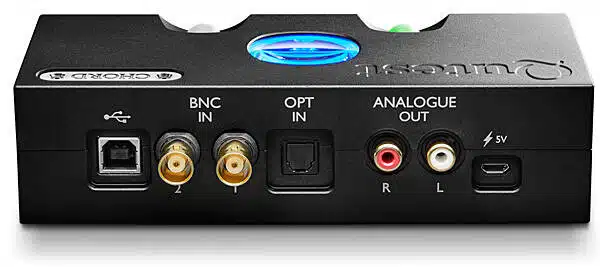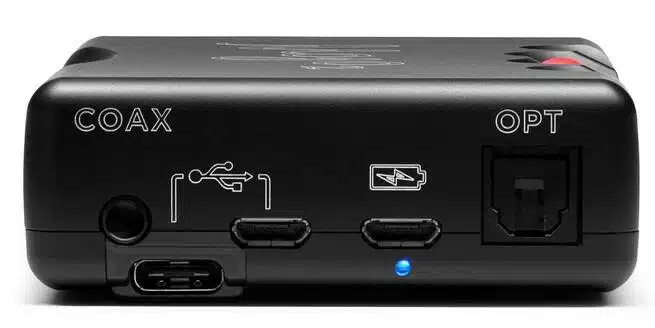
Chord Electronics is a highly respected British audio company that has been producing high-quality digital-to-analog converters (DACs) for over three decades.
Its products are known for their exceptional sound quality, unique features, and innovative designs. But with so many different DAC options to choose from, like the Mojo 2 and the Qutest, which one should you buy?
Chord’s Mojo 2 and Qutest are similar DACs with a strong emphasis on small form factors with excellent performance. The Mojo 2 has more inputs, a warmer sound signature, a built-in battery, and can play music from an SD card, while the Qutest has slightly easier controls and a more neutral sound.
The Chord Mojo 2 and the Chord Qutest may have been designed and built by the same company, but they have entirely different target markets, which also means they have unique features.
Let’s compare the two DACs more closely so you can decide which feature set is the ideal match for your purposes.
Table of Contents
Design And Build Quality
The Chord Mojo 2 (on Amazon) and Qutest are small devices designed to deliver excellent sound quality in a slim form factor. Both are well-built from high-quality aluminum, creating a sturdy case that feels great to hold.
Neither device looks as impressive as some of the other DACs on the market. They have a sleeker and more modern look rather than the stylish design of competing devices, but this particular look will also appeal to many users.
The Chord Qutest has a minimalist design. It’s essentially a rectangular black box with no screen and no buttons cluttering up the front.
Instead, it has colored LEDs that indicate the sample rates and frequencies, with a singular multi-color lens at the top, which looks impressive despite not serving much of a purpose. This does make it look quite high-tech, though.
The Mojo 2 is similar – it’s a small rectangular black box with no screen but four colored LEDs to display the current settings.
Overall, the Mojo 2 looks more polished than the Qutest. However, keep in mind that neither device exactly looks “premium.” They don’t look like high-end audio equipment but are pretty reminiscent of the old Sony Walkman in some ways.
That’s not a bad thing for everyone, though; the devices are eye-catching, making them great conversation starters.
Also: JDS Labs Atom vs FiiO K5 Pro
Input/Output

The Chord Qutest offers the following input options:
- USB Type B 2x
- BNC Coaxial (Can also be combined into 1x Dual data mode input)
- Optical
In terms of output, it offers the following:
- 1x Stereo RCA

On the other hand, the Mojo 2 offers these inputs:
- Coaxial
- Dual-data Coax
- Optical
- Micro-USB
- USB-C
It offers the following for output:
- 2x 3.5 mm Headphone jacks
From the output options, it’s clear that both devices fill niche roles, and they are not meant to offer a variety of output options. However, each has a good set of input options, though the Mojo 2 is slightly better than the Qutest in this aspect.
It would be best if you considered the audio port of the device you’ll be connecting the DAC to before you choose between these two DACs.
Unique Features
Both the Chord Mojo 2 (Amazon) and Chord Qutest are packed with unique features that set them apart from other DACs on the market.
The Mojo 2 features Chord’s proprietary FPGA-based digital processing technology, which allows it to reproduce music with exceptional clarity and detail.
It also has a built-in headphone amplifier that can power a wide range of headphones, from sensitive IEMs to power-hungry planar magnetic models.
Two other aspects that set the Mojo 2 apart are the fact that you can play music from an SD card, which you can insert directly into the Mojo, and the device is portable with a built-in battery. Note that the battery doesn’t last very long and takes a long time to charge, though.
The Qutest, on the other hand, features Chord’s latest digital processing platform, which delivers even better sound quality than its predecessor. It also has a galvanically isolated USB-B input that eliminates the potential for ground loop noise.
Another thing that the Qutest has going for it is that it draws its power from the USB input. Since it only draws 5V, it’s actually possible to use it as a portable device if you connect it to a battery-based power source, such as a power bank.
Also: iFi Zen DAC V2 vs FiiO K7
Technical Specifications
The Chord Mojo 2 is powered by a pair of THX AAA-78 amplifiers and two custom-designed DAC chips, which support PCM sampling rates up to 768kHz and DSD512.
The DAC chips use Chord’s proprietary FPGA-based digital processing technology, which allows for unparalleled accuracy and detail in the digital-to-analog conversion process.
The Mojo 2 also features a galvanically isolated USB-C input, which helps to eliminate noise and interference from the computer or mobile device it is connected to. Other inputs include a coaxial input, an optical input, and a 3.5mm analog input.
The Chord Qutest, on the other hand, is based on a custom-designed FPGA chip that also supports PCM sampling rates up to 768kHz and DSD512. The Qutest features a highly accurate clocking system that ensures jitter-free playback, and it has a galvanically isolated USB-B input that eliminates the potential for ground loop noise.
The Qutest also has two optical inputs, a coaxial input, and a 3.5mm analog output, as well as a pair of RCA outputs for connecting to an amplifier or powered speakers.
One key difference between the Mojo 2 and Qutest is their respective amplifier technologies.
The Mojo 2 uses THX AAA-78 amplifiers, which are known for their low distortion, high output power, and low noise floor. These amplifiers are designed to deliver maximum transparency and accuracy, making them an ideal match for the Mojo 2’s high-resolution DAC chips.
The Qutest has no built-in amplifier, so you must use it with an external amplifier or powered speakers.
In terms of power consumption, the Mojo 2 requires up to 7.5W of power when connected to a USB-C power source, while the Qutest requires just 2.5W of power when connected to a USB-B power source. Both devices are highly portable and can be used with a vast range of devices, including computers, smartphones, tablets, and portable music players.
Sound Quality
When it comes to sound quality, both the Chord Mojo 2 and Chord Qutest deliver exceptional performance.
The Chord Mojo 2 (Amazon) has a slightly warmer, more organic sound signature that is highly engaging and musical. It also has an excellent dynamic range and low-end extension, making it ideal for bass-heavy genres like electronic music and hip-hop.
In contrast, the Qutest has a more neutral and analytical sound signature that is highly revealing and detailed. It also has excellent resolution and imaging, making it ideal for musical styles like classical, jazz, blues, and acoustic music.
User Experience
The user experience on both devices is excellent if you know what to expect.
Users who like to tamper with all their settings and fine-tune every tiny piece of their music will find them both severely lacking. They are not as customizable as some of the other (and more expensive) options out there.
The fact that they don’t have analog or digital indicators also frustrates some users. There’s no LED screen to display your EQ settings and volume graphs. You can’t turn a knob to get your volume or amplification to an exact percentage. In these aspects, the user experience isn’t all that great on either of the two devices.
However, one of the advantages is that both devices are easy to use. Users who don’t want to fiddle with every setting and enjoy excellent sound quality without necessarily understanding every little detail it entails will be delighted with these DACs. Their basic settings are optimized to be more than adequate for most audiophiles.
It’s worth mentioning that both devices can connect to a computer, and with the appropriate software, you can configure more settings than you can with the built-in buttons and controls.
Users who want a clean, clinical sound will appreciate the Qutest. It gives an excellent musical experience when you want to listen to the music the way it was recorded with no additional fidgeting.
Anyone who prefers a warmer and more natural sound should opt for the Mojo 2 instead. It delivers excellent audio output, full bass, and a genuinely warm and welcoming sound signature.
Many users find they love the Mojo 2’s portability. Its small form factor and built-in rechargeable battery make it great for listening to high-quality audio on the go. It’s a bit heavy to carry with you when you go for a jog, but it works well when you’re commuting.
Unfortunately, the battery doesn’t last long. Chord rates it as potent enough to last for “over eight hours,” but experience puts this closer to five or six hours; it probably depends on your listening habits.
But it also takes a long time to charge, so don’t expect to use the Mojo 2 in the same way you use wireless headphones. You will need a bit of downtime to let it charge to full again.
Final Words
The Chord Mojo 2 and Chord Qutest are both excellent DACs, though they are not ideal for hardcore DAC enthusiasts. The Mojo 2’s portability and the built-in audio player really sets it apart, while the Qutest is a slim and potent desktop DAC.
Those who prefer a neutral sound will love the Qutest, but anyone who likes their bass or prefers a warmer sound should go for the Mojo 2 instead.

Hi, I’m Raymond. A keyboard player, music producer, and writer. And I’m also the founder of this blog. As someone who has been working with several audio and music equipment and different musicians for many years, my goal is to answer all your questions on music and equipment, as well as the latest music software and technology. For more info, check out my about me page

